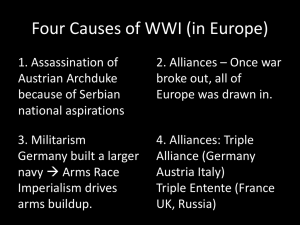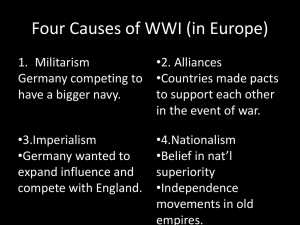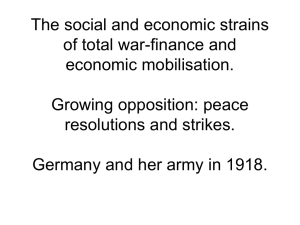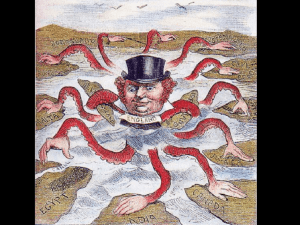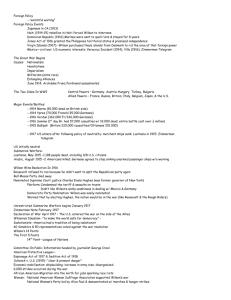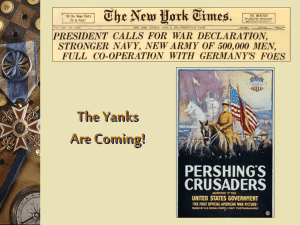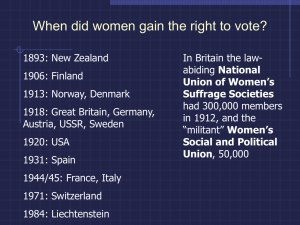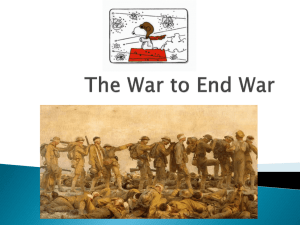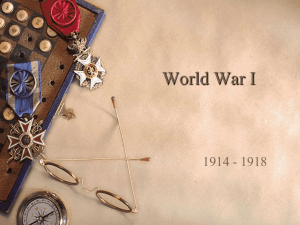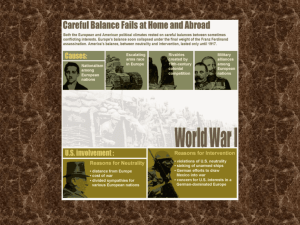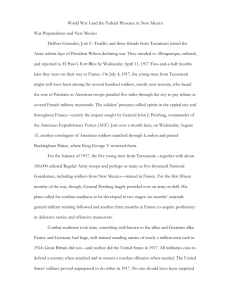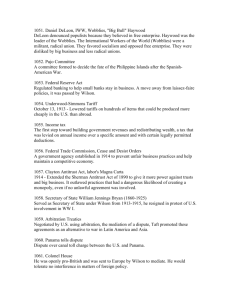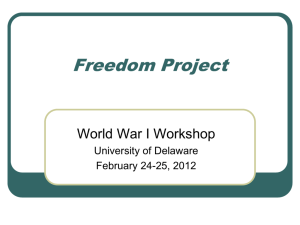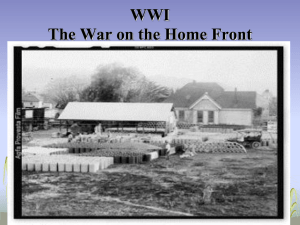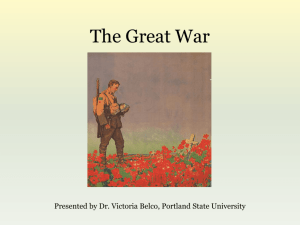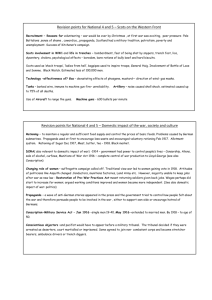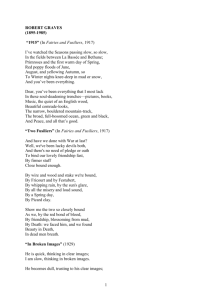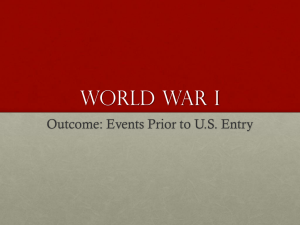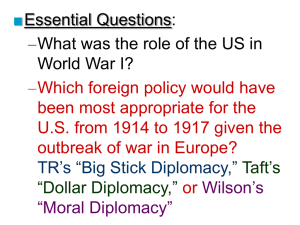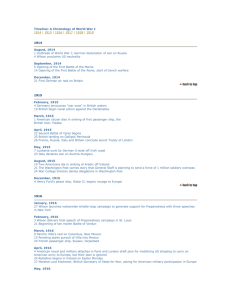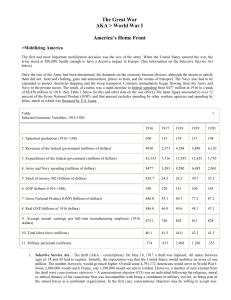American interests
advertisement
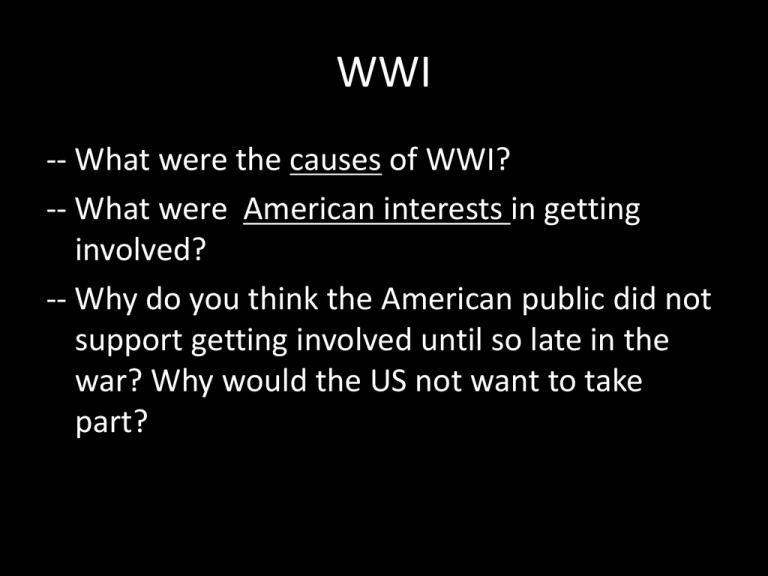
WWI -- What were the causes of WWI? -- What were American interests in getting involved? -- Why do you think the American public did not support getting involved until so late in the war? Why would the US not want to take part? In 1914, the British Empire covered about ¼ of the world’s land and ruled over about 1/5 of it’s population. Human cost of WWI • 10 million military and 7 million civilians were killed in the war. (~ 117,000 Americans). • 20 million died of hunger and disease related to war. – Spanish Flu killed 600,000 Americans and over 50 million worldwide in 1918 and 1919. War in Europe Woodrow Wilson • Insists on “open door” to make the world safe for democracy. • 1918 – endorses women’s suffrage as vital for winning the war. (by 1917, 16 states had given women the right to vote). • Obsessive fear of disloyalty: – Espionage Act (900 people sentenced to prison during war) – Sedition Act – Selective Service Act – Trading with the Enemy Act – Alien Enemies Act – Alien Act National War Labor Board NWLB • To mediate disputes, recognize fair wages and hours, collective bargaining. • War Labor Policies Board – Set standards for federal employees 1. Lusitania and Submarine Warfare • British passenger ship – sunk by Germany 1915 because they claimed it carried weapons. Germany declared unrestricted warfare on British ships. • British denied it was carrying explosives. • British responded with a naval blockade on Germany. This prevented the US from trading with Central Pwrs. • Over 1000 people killed 126 Americans killed. Neutrality? • William Jennings Bryan: Wilson practiced a false neutrality by allowing US passengers on ships that we know might be sunk. The ships are not neutral. 2. Mexico and the Zimmerman Telegram • Germany sent a Telegram to Mexico offering lost territory (New Mexico, Texas, Arizona) and financial support if Mexico joined Germany in war against the US. • Intercepted by London. US declared war as result. • US had invaded Mexico with 11000 troops in 1916 to chase Pancho Villa. US Cavalry invading Mexico in pursuit of Pancho Villa in 1916. 3. Trade and Economics Making the World Safe for Democracy • US experienced economic boom because of war orders from Europe. (before US entry). • US gave loans to European countries to finance war. • Germany and UK blockaded each other to stop US imports. Germany sank all ships bound for Britain. Britain responded with blockade on Germany which ended US trade with Germany. • US loaned $2bil to UK; 27 mil to Germany. • Lend-Lease Program: US will supply arms with no payment until after war. Trade and Economics • In 1917, the estimated cost of the war was $3.5 billion. – Actual cost: $35 billion & 116,516 US soldiers. • The US had loaned $2 billion to Britain and France before entering the war, compared to $27million to Germany. Tax Base • Before the war, most of the government’s revenue came from tariffs. • In 1917, the War Revenue Act was passed, imposing an “excess profits levy” as high as 60%. – Fed. Revenue went from $930 million in 1916 to $4,388 million in 1918 • The personal exemption for income tax went from 3,000 – 1,000 • Tax on earnings above $500,000 went from 7% to 77% – Thus the income tax became the most important source of federal revenues. 4. Demographics • Americans divided on entry into war. Economic benefits of war. • Isolationism: Idea that US should not get involved. Socialists, Progressives especially opposed the war. • US army 1914: 98,000; 1917: 4 million. Demographics • 1/3 of Americans were 1st or 2nd generation Germans. – These 8 million Germans and another 4 million Irish did not love England. • National Defense Act of 1916 expanded Army from 90,000 to 175,000 – While Wilson was still maintaining a policy of neutrality, a draft was instituted to expand the army. US Army • 1917: US Army was the 7th largest in the world. Equipped with old weapons and only had a day and a half of ammunition in reserve. – Spring, 1917: Army + Nat’l Guard =379,000 – End of War: 3.7 million • Early summer, 1917: token American forces and the French Army was plagued by mutinies. • March, 1918: 300,000 Americans in France • November, 1918: over 2 million! • (1,400,000 of them saw action) • 367,000 African American troops 5. Wilson, WWI and Progressivism World War and the death of Progressive Party • By 1916, Progressives became extremely committed to the defense of national honor, nationalism, and opposition to Wilson. But, imperialism and militarism replaced old liberal formulas of protest, and within a year, the party was dead. • War was justified with progressive rhetoric and on progressive terms. – Discredited progressive language – morals and ideals – Guaranteed that anti-war reactions would be antiprogressive. Civil Society on the eve of war 1913 Armory Show, Chicago $45,000 worth of paintings sold! Duchamp’s Nude descending a Staircase (or, explosion in a shingle factory) Wassily Kadinsky – Improvisation #27 – Garden of Love Matisse’s work was chosen by students at Chicago's Art Student's League as the most appalling and blasphemous pictures in the exhibition. The charges brought against him were "artistic murder, pictorial arson, artistic rapine, total degeneracy of color, criminal misuse of line, general aesthetic abberation, and contumacious abuse of title“ Troubled by the public’s reaction to his work, Matisse said in an interview: "Oh do tell the American people that I am a normal man; that I am a devoted husband and father, that I have three fine children, that I go to the theatre!" Meanwhile, in Europe, the press had been paying attention to the Caillaux affair. Joseph Caillaux, former premier and current minister of finance and radical socialist leader in France was accused of high crimes and misdemeanors. His wife was enraged by how the press had destroyed his career. She decided to solve the problem by buying a gun and killing the responsible journalist. When news arrived of the assassination of the Archduke Franz Ferdinand in Serbia, it seemed only a brief distraction from the Calliaux trial. How did the war affect the Economy? • • • • -- Unions -- Wages -- Production -- Taxes How do you think the war affected politics? WWI killed 10 million in battle 2 million died of hunger related to war Efforts to save grain led to the 19th Amendment– prohibition. 1915-1918: the real income of farmers grew 30% $20 billion were raised with Liberty Bonds Bernard Baruch, head of the War Industries Board (WIB) Women working in a shipyard, 1918 1918, the government wanted to encourage women to work on farms to keep food production up. Women in the Workforce Wartime policies and economic changes wound up killing progressivism, even though progressives were in power. Why do you think?
